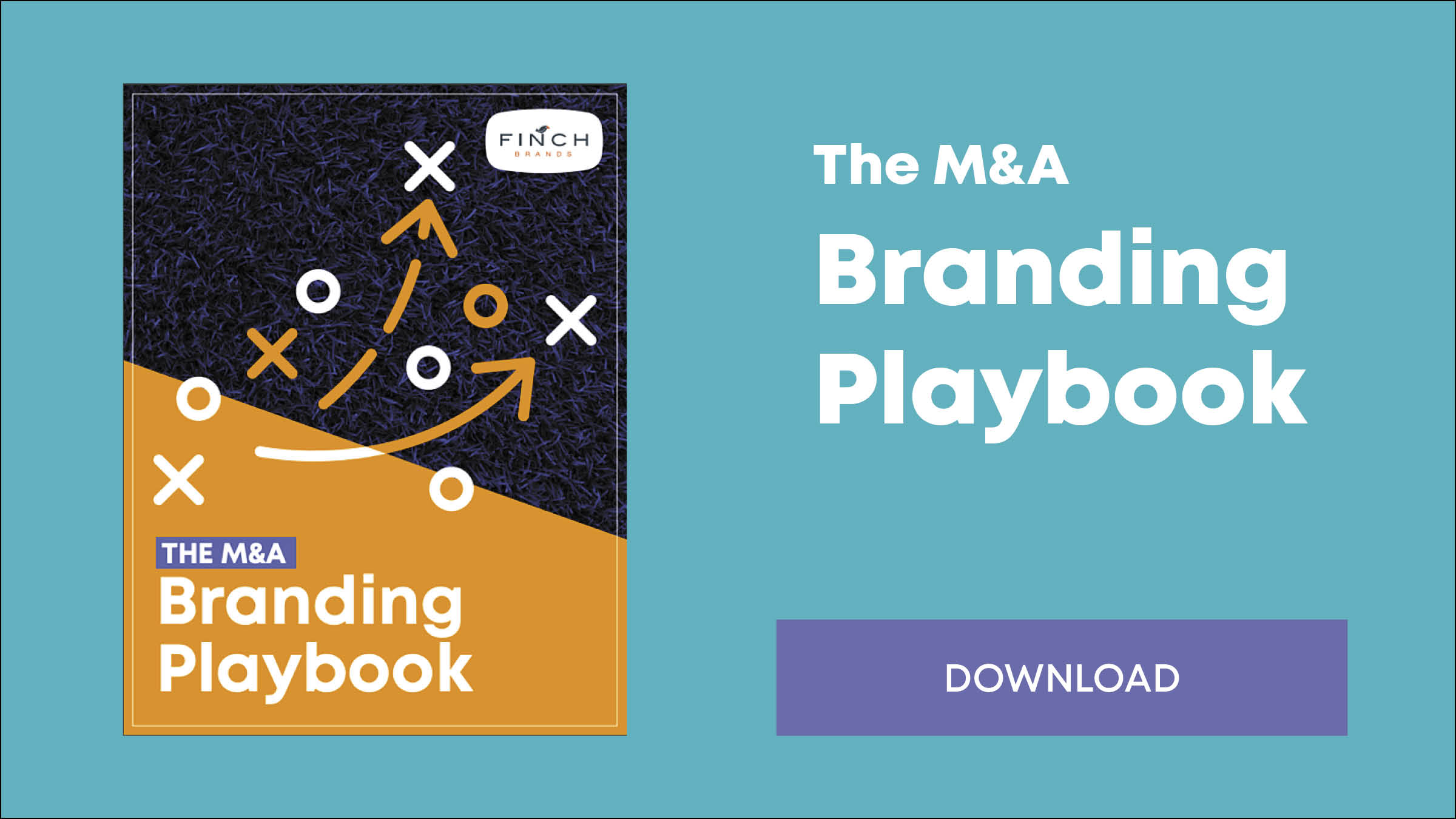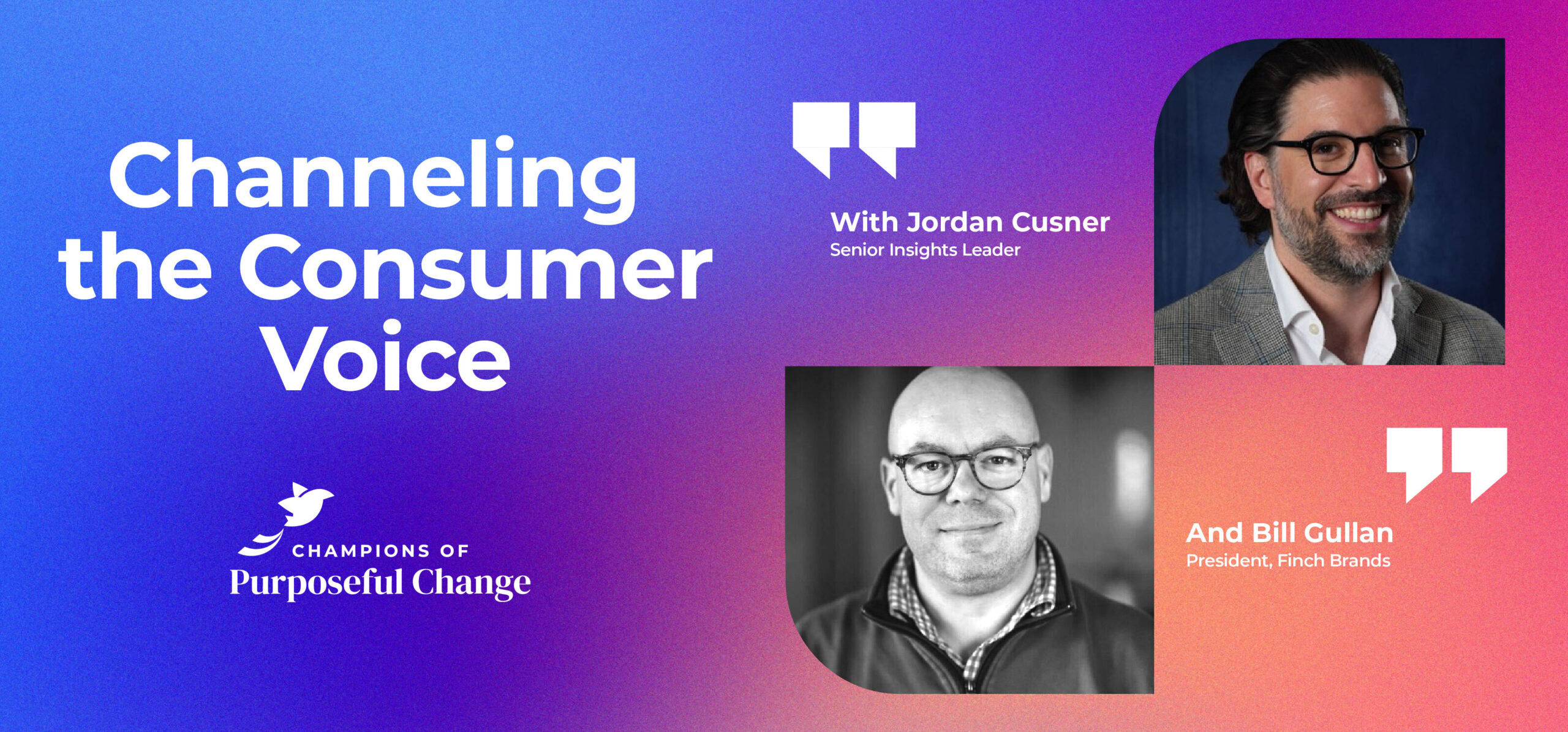Full M&A Branding Playbook

Full M&A Branding Playbook
Over the past couple weeks, we’ve broken our M&A Branding Playbook into sections – today’s episode is a full audio version of the Playbook! This represents our compendium of best practices for how to define and execute key branding choices in the wake of M&A activity. If you like our podcast, please subscribe and share with your colleagues, friends, and family.
Podcast: Download Subscribe: iTunes | RSS

Transcription:
Bill Gullan:
Greetings one and all this is Real-World Branding I’m Bill Gullan President of Finch Brands a premier boutique brand consultancy. Thank you for joining us. So, I’m sure you follow our podcast with bated breath waiting for the next episode. You may have noticed that over the past three editions we have broken our M&A Branding Playbook down into digestible parts that are thematically aligned, that are bite-sized, that are consumable. Now what we wanted to was present the whole thing in one place, just in case that was a more convenient way for you to listen and consume this content. So, the entire playbook, which I think is written, and you can certainly get a printed copy from our website. It’s probably eighteen, nineteen pages, I mean it’s designed so who knows. It’s been fun doing an audiobook version of the things that we wrote but so here without interruption from beginning to end, enjoy the M&A Branding Playbook from Finch Brands.
Bill Gullan:
The M&A Branding Playbook. Executive Summary. To activate the full potential of a merger or acquisition, leadership teams must seize opportunity and manage risk across a range of dimensions. Within this endeavor, branding is critical and often overlooked, as a work-stream. M&A branding is the process of defining the core elements of the go-forward brand or brands and navigating the path to get there. It includes strategic topics, such as core brand ideas, positioning, target market, and brand architecture. And it includes creative topics such as name, logo, and aesthetic. And it includes executional topics such as how the brand can be most effectively launched and nurtured, internally and externally. This piece is designed to educate decision-makers on M&A Branding best practices.
Bill Gullan:
Introduction. Mergers and acquisitions are more than formulaic transactions. They’re strategic initiatives intended to drive something greater than the sum of the individual parts of the deal. Likewise, the M&A Branding process is more than just checking off a series of boxes or deciding which name to attach to the acquired company. It’s a larger, more complicated endeavor, that involves navigating both market expectations and stakeholder emotions. When it comes to M&A Branding, the right path forward is unique to each situation. There’s no path of least resistance or hard and fast ruleset. In order to activate the full potential of the deal from a branding perspective, companies must dig into the issues, gather insights, build a strategy and thoughtfully introduce go-forward brand choices, both internally and externally. Our experience suggests that the M&A Branding workstream is often overlooked or treated as less important than other integration activities. This leads to decisions that are either too rushed or too lethargic, clumsy integration processes, employee, or customer alienation, and brand equity destruction. When the M&A Branding process fails, the deal thesis fails with it.
Bill Gullan:
Section one, why is M&A Branding so important? A brand is the sum total of how a company defines and expresses itself. It’s how a company asserts difference and sets expectations with everyone, from team members to customers, to other stakeholders. Brand building is important for any company, but especially so in the case of M&A. In a transaction, the newly formed organization and its brands are in transition by definition, the company is not only setting expectations. It might be setting out to change them. Thus, the team is tasked with assessing already established brands, considering everything that comes with them, such as heritage, emotion, vision, and more, and charting a path forward. And these decisions are often made against a backdrop of time pressure, many moving parts, and team and market uncertainty. This is the branding equivalent of a high wire act.
Bill Gullan:
When done well, M&A brand development sends important signals to all stakeholders about the vision of the emergent entity. It not only sets the stage for what’s next, but answers questions about what’s happening during an integration process. For employees, customers, and other stakeholders of both the acquiring and acquired companies, the M&A Branding process can provide guidance, ease frustrations, and rally everyone around the same common goal. Yet, M&A Branding is not without risk. 70 to 90% of mergers fail to create value for their employees, customers, and stakeholders, and inadequate branding processes are often to blame. When the wrong brand choices are made or important considerations are ignored completely, one risks large-scale brand equity destruction or failure to create new brand value. Get branding right, and the cultural and commercial aspects of M&A have a much higher likelihood of success.
Bill Gullan:
Section two, start with listening. A comprehensive, yet efficient, active listening process informs key decisions and sets the stage for cultural buy-in. As with most M&A decisions, the branding process involves navigating the many data sets, opinions, emotions, and needs of employees, both existing and new, customers and other stakeholders. And while it’s impossible to create a go-forward brand plan that aligns to everyone’s expectations, learning from and getting buy-in from all groups is crucial to the success of the branding process. The process by which branding decisions are made is often just as important as the content of those decisions. A wider process helps ensure people get behind the forward-thinking brand direction. There is a time to listen and a time to lead. This process is not about advocating leadership’s responsibility, but rather collecting insights and identifying opportunities and risks so that decision-makers have an informed well-grounded perspective.
Bill Gullan:
Creating a comprehensive yet efficient stakeholder insights process can ensure decision-makers are well-informed when it comes to perceptions, risks, and opportunities of various branding directions. Employees. The best brands are built from the inside out. Team members from both current and acquired companies should be welcomed into the process regardless of the structure of the deal, and also be considered a key target audience for process outputs. There are two reasons for this, insight and emotion.
Bill Gullan:
In terms of insight, customer-facing team members see the brand through the clearest lens and can help leadership understand reputational factors germane to decision-making. Often companies involved in an M&A process were previously competitors. This brings a valuable practical perspective to brand equity and the strengths and weaknesses of brands and the deal. Emotion plays a significant role in a change of this magnitude. Engaging employees in this process makes them feel valued and promotes a sense of leadership transparency and integration process that doesn’t harvest teammate insight and manage emotion, risks cultural disunity, lower employee engagement, and loss of top talent. Employees on all sides seek to understand how leadership sees the future of the organization.
Bill Gullan:
Team members, both current and from acquired companies might have concerns about where they fit within the go-forward company and how an evolving culture will shape their day-to-day reality. For this reason, the HR function is a critical partner in the M&A branding effort. Customers, customers of both the acquired and acquiring businesses are obviously key constituents with short and long-term questions that require ready answers and confident communication. Within the learning process, customers and prospects help inform key branding decisions. A skillful voice of the customer insights program can help leadership do the following things. One, understand the relative strength and meaning of existing and acquired brands. Two, help assess opportunity and risk of possible brand changes. Three, document areas of strength and or weakness in the customer journey. Four, expand the company’s point of view on the dynamics shaping the category and customer. Five, uncover customer needs that are not being well met today.
Bill Gullan:
Six, document competitor strengths and reputation. And seven, road test messaging and other post-M&A directions. With the above data in hand, leadership can begin to approach key brand questions around messaging, brand architecture, nomenclature, design approach, and beyond. As noted, this process need not be slow nor expensive.
Bill Gullan:
Other stakeholders. The incredibly high failure rate of mergers and acquisitions often leaves other stakeholders feeling on edge. The go-forward company can provide peace of mind by clearly conveying the benefit and vision for the future of the company. Gathering insights and aligning expectations to them can bring investors, partners, the media, suppliers, and other relevant stakeholders on board with greater efficiency.
Bill Gullan:
Section three, make and document key choices. While a great deal of work goes into the foundation, the overall process is shaped by several key visible decisions that influence the integration process, including some of the following, brand strategy, the brand strategy documents the core ideas on which the emergent company is based. It sets forth the M&A rationale from a branding perspective and defines the go-forward story and its key elements. It establishes for the market and team the basis on which the post-integration entity will compete and win. While the brand strategy is not necessarily public-facing, it acts as a sort of constitution for the company and influences all that comes after.
Bill Gullan:
Informed by various stakeholder insights processes, the brand strategy will include the following positioning for what will the emergent entity stand, target on whom will the emergent entity focus in the sales and marketing realm? Architecture, how will brand relationships be structured and conveyed? And personality, what will the emergent entities’ notable stylistic qualities be? Part of the larger brand strategy, brand architecture is the structure of how a brand is organized. While M&A activity creates a whole range of brand architecture needs as product lines merge, for example, the highest level of architecture, the corporate name, and logo is one of the most important.
Bill Gullan:
There are four prevailing M&A corporate identity brand architecture strategies as follows one, no change. The acquiring company leaves the brand of the acquired company alone, creating a house of brands approach that maintains distinctive sub-brands after the deal is complete. It’s generally best used in mature categories. When the brands in question are already clearly differentiated and or positioned to different customer segments. Two, fusion. Both partners in a merger or an acquisition integrate brand identity assets into an involved corporate identity, this approach is geared more towards managing risk than activating potential, preventing large-scale team and customer alienation. It heralds newness but references key deal components in ways that convey connection to heritage. One-off used fusion example is an endorsed brand architecture in which the acquired company is powered by or a division of the master brand.
Bill Gullan:
Three, stronger horse. One brand often of the company that initiated the acquisition or the larger, more dominant brand is elevated. It’s simple and clear, but there are risks related to brand equity and customer relationship destruction. This approach requires significant communication to both the team in the marketplace. And four, new brand. Development of an entirely new identity. It’s usually most appropriate in categories undergoing a high degree of transformation. This approach can be costly, time-consuming, and risky as it relates to protecting brand equity and customer relationships. But it has the greatest ability to create something that is perceptually new and innovative.
Bill Gullan:
Each approach has its own pros and cons. The right answer is based on company, category, customer, culture, and other distinctive situational characteristics. While these options define the desired steady-state, it is also very likely that going from here to there requires a migration strategy that documents transitional steps and key milestones along that journey. For example, a company may use an endorsed brand architecture to connect M&A brands for a period of time. The intent of a migration strategy is to protect brand equity during a transition.
Bill Gullan:
Brand design. While there are a range of downstream design questions, the focus here is on-brand design at the visual identity level. How will the logo system and overall style of the brand shift post-M&A? If a new name is adopted, that will clearly prompt design needs yet progressive brand design can signal newness and freshness post-M&A even if existing names remain in place. There are a variety of reasons to use the M&A moment as the right time for a design refresh, such as it conveys to the market a sense of progress and energy to go along with M&A activity, it conveys to acquired company employees that their integration makes a difference, and it takes advantage of a newsworthy window to introduce something new and get noticed. The role of brand design is to express the ideology and spirit of the emergent entity. There are a range of ways to do that. Sometimes even the name and logo can remain, but a company can use surrounding styles or particularly high-value assets, such as website, packaging, trade show booth, et cetera, to think differently and chart a future course.
Bill Gullan:
Section four, Built From the Inside Out. The best brands are built from the inside out. This is because an engaged, purposeful workforce goes to market with urgency and takes great care of customers at every turn. Teammates are both an important input through the research recommended above and target audience of an M&A branding process. There were a couple of key moments and workstreams that are ideal for broad team involvement. As mentioned, existing and new teammates should be part of the stakeholder insights process. It often makes sense to ratify revised purpose, mission, and value statements alongside M&A in a way that includes new leadership voices and broader workforce involvement. Internal brand education and launch should be just as big of a milestone as the external launch. It should precede the external launch, bringing the team on board before rolling out new brand elements and changes to customers and outside stakeholders.
Bill Gullan:
Purpose, mission, and values. Purpose, mission, and values are fundamental internally facing artifacts and M&A activity can be a great time to evaluate or create these elements. Evaluating or re-evaluating these assets during M&A integration can provide a team-building visionary exercise for new management teams and inspire existing and new teammates to understand and endorse the company’s direction.
Bill Gullan:
Core building blocks. Purpose. The definition is to focus on dreaming and define our ambition. The role is to be the north star, to guide the big bets, to inspire. And the timeframe is future-focused and long-term. The mission. The definition is to focus on doing, to document how we achieve our purpose. Its role is to answer what, who, and how to guide day-to-day decisions, but also to inspire. And the timeframe is present-focused. It’s ongoing. And values. The definition is a focus on living, how we practice it. The role is to communicate how behaviors help us fulfill the purpose and mission. And the timeframe is present-focused. It’s action-oriented and it’s ongoing.
Bill Gullan:
Importantly, while management teams typically work through purpose and mission, it is strongly recommended that the process of ratifying values include all teammates. Leadership can build some guardrails and then deploy a full team value survey. Once results come back, the team can craft final action-oriented values with leadership input and approval. This way, the process is both efficient and inclusive. And M&A branding process that harvests employee input on the front end and then involves broad input on values will feel and be transparent and inclusive.
Bill Gullan:
As the team approaches the day one launch, there will be a whole range of new things to learn and share, including such fundamental elements as messaging identity and go-to-market strategy. Team members are the most important ambassadors and they will be essential in ensuring customers understand where the brand is going and believe in a company’s evolution. It is, therefore, critical that one crafts an internal brand curriculum and launch cadence before the brand is introduced externally. While internal brand education should have a range of associated activities, such as town halls, CEO video series, team-building training, and artifacts such as brand book onboarding materials and other swag, the overriding objective is to provide an experience that will inspire all employees. Employees who understand and believe in the brand will take the actions that drive business results.
Bill Gullan:
Leadership should also endeavor to make day one a meaningful company milestone and provide an opportunity for the entire organization to celebrate the hard work that went into the integration process and the entity that has been reborn or born through M&A.
Bill Gullan:
Section five, Make it Real for Customers. With key elements in place and the team poised to bring the emergent brand to life in the marketplace, the company could focus on external activation. Importantly, customers will have short and long-term questions and maybe less concerned initially with our future vision than immediate blocking and tackling. For this reason, it is ideal for the company to have an ongoing conversation with customers that starts when the deal is announced. During the integration period, the company could reassure customers that the team is on top of what matters to them while beginning to express how M&A will make life better for customers in the long term. As one prepares for the actual brand launch or day one, there may be an opportunity to share a new identity or look and feel. At the very least, this moment should be widely seen and positively experienced by customers.
Bill Gullan:
Plan the work. Depending on the size and structure of the business, the M&A customer communications plan can be a significant task. While a range of team members and sales and marketing touchpoints disseminate the message, it is important to achieve messaging and design clarity and consistency. The task will seem manageable with a regular high-energy cadence that begins before the day one deal announcement and extends all the way to and through launch. This plan will be highly variable based on the company in question and will include customer and prospect communications for all companies in the deal. It is likely a mix of press releases, update emails, leadership update videos, social media posts, integration update blog items, et cetera. The goal is to be transparent, reassuring, and positive so that customers know support is available to them even as plans are underway for an ever brighter future of new opportunities for the company and its customers.
Bill Gullan:
Maximize day one. A key milestone is day one, the actual launch of the new brand. This need not track exactly what the formal legal or regulatory consummation of an M&A transaction. In fact, companies sometimes take unnecessary risks by racing to match brand day one with legal day one, short-circuiting a best practice-driven M&A branding process. As long as the communications plan is well-executed, it is usually okay for brand day one to be a date of the company’s choosing such as to coincide with a key trade show, a new quarter, or other milestone event. Typical day one activities include a new website going live, an earned media press push, wide dissemination of new brand content, virtual or live events, and some form of account or sales contact to each customer.
Bill Gullan:
The goal is to maximize the spotlight that comes with something new and noteworthy, which is what M&A creates. Day one itself should be momentous, but it need not be a complete flip of the switch. The marketplace understands and tolerates an orderly process to update downstream elements such as collateral business cards, signage, and other artifacts. Consistency ultimately matters a great deal yet it’s okay if it takes a little while to achieve. The brand rollout plan 10, for instance, cover pre-day one, day one itself, and day one to 100.
Bill Gullan:
Get started on the M&A branding journey. The M&A branding process impacts all levels of the organization and involves much more than a design refresh. Companies will often form a task force or integration management office, otherwise known as an IMO, to cut through bureaucracy and focus on key integration topics. Beyond branding, this usually includes operational integration, value capture, organizational structure and leadership, and other key items. Finch Brands typically manages the M&A branding workstream for clients across sizes and categories. Because of the complex questions associated with M&A branding, we have a range of experiences on which to drop and a team of fearless and versatile experts to deploy. Finch Brands’ history of building running and growing brands fuels the strategic insight and design excellence we deliver to help clients navigate the high-stakes M&A branding process.
Bill Gullan:
Thank you all for listening this has been really fun not only to gather our thoughts from many engagements that were focused on M&A brand choices, to document those best practices, to share them in written form as well as in verbal form and we hope that you’ve enjoyed it. We’d love to discuss further as you encounter situations like this. I think if there’s one kind of closing thought on this, which I think tended to reiterate across the expanse of the piece is that the right answers here are highly situational. They have to do with company and category dynamics. So hopefully this has been a helpful framework for making a list, building a plan, and thinking through some of these key questions. Obviously as you undertake an M&A situation in the real world the content that comes from the distinctive nature of that situation will help guide you to the right answers. We really appreciated your interest in this and we will sign off from the cradle of liberty.







